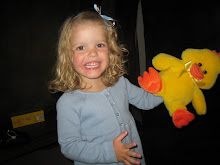Gracie is doing wonderfully and now when her sisters tell her they get to go to school she enthusiastically tells them, "I get to go to the doctors!" We are looking forward to round two starting a week from today.
Our new friend Noah is going to start his chemotherapy treatments tomorrow. While we have never met Noah and his family we are excited for them to begin their treatments. It is good to be started on the path to being cancer-free. We admire their family's faith and courage throughout the past week.
Now for the original purpose of this post. Some have asked us why retinoblastoma is a childhood cancer and why it does not affect adults. I often wondered this myself and came across the answer in a book called "Childhood Cancer: A Parent's Guide to Solid Tumor Cancers" by Honna Janes Hodder & Nancy Keene. The Candlelighters (A childhood cancer foundation) sent it to us a week ago. It talks about how immature retinal cells are called retinoblasts. These cells grow in the fetus and early years of a child's life into the rods and cones found on the retina (rods and cones detect light and send signals to brain so that we can all see). Once the retinoblasts have formed mature rods and cones they lose the ability to multiply. It was in the division and multiplication that the mutations had occurred to start the tumors, so without this function there is little risk of a tumor growing.
I found a good explanation on the website for the Children's Hospital of Philadelphia (http://www.chop.edu/consumer/jsp/division/generic.jsp?id=78814). I will paste it below.
What is retinoblastoma?
Retinoblastoma is a rare cancer originating in the part of the eye called the retina. The retina is a thin layer of nerve tissue that coats the back of the eye and enables the eye to see. Most cases involve only one eye (unilateral), but both eyes may be involved (bilateral). If retinoblastoma spreads, it can spread to the lymph nodes, bones or the bone marrow. Rarely, it can involve the central nervous system (CNS).
Retinoblastoma is a malignant tumor composed of retinoblasts (immature baby cells) in the retina. These cells form the nerve tissues (rods and cones) at the back of the eye. Their job is to form images. The images are then transmitted by the optic nerve to the area of the brain responsible for sight.
Retinoblasts develop from a single cell during the early development of an infant in the womb. During gestation and early life, these cells are able to divide and multiply. This is the process that helps make enough cells to populate the retina. As children age, their cells undergo a process called differentiation and become mature rods and cones. The cells are no longer able to divide and multiply, which is why retinoblastoma occurs very rarely after the age of 5 years. Children may be born with retinoblastoma, but the disease is rarely diagnosed at birth.
We do not know what causes retinoblasts to turn into cancer cells but we do know that it in order for retinoblastoma to develop there must be a change or mutation in both copies (one from each parent) of a gene called RB1. What precisely triggers this change or mutation is not known.
Most children who begin treatment before the retinoblastoma has spread beyond the eye are cured. A major goal of treatment in children with retinoblastoma is preserving vision.
Great strides have been made in treating retinoblastoma in recent years; many children retain their vision and more than 95 percent of children with retinoblastoma can be cured.
Subscribe to:
Post Comments (Atom)



No comments:
Post a Comment